Microsoft is making a monumental leap into the dedicated handheld gaming arena, not by going it alone, but through a significant collaboration with PC gaming hardware titan ASUS. This partnership, unveiled with considerable fanfare at the Xbox Games Showcase, heralds the arrival of two new devices: the ROG Xbox Ally and the more powerful ROG Xbox Ally X, set to redefine portable Xbox gaming.

This strategic alliance is a fusion of strengths. ASUS brings its well-established prowess in crafting high-performance, innovative gaming hardware, notably its experience with the existing ROG Ally family of devices. Microsoft, in turn, contributes its expansive Xbox ecosystem, a rich library of games, and its software expertise, particularly in tailoring the Windows experience for this new form factor. This collaborative approach allows Microsoft to enter the competitive handheld market by leveraging the proven design and manufacturing capabilities of a seasoned hardware expert. Such a strategy mitigates the substantial risks and R&D costs associated with developing entirely new hardware from scratch, especially in a field with strong contenders like Nintendo and Valve’s Steam Deck. It also enables Microsoft to concentrate on its core competencies: refining the Xbox software interface, ensuring seamless Game Pass integration, and expanding the overall Xbox platform’s reach. This model could very well serve as a blueprint for future “Xbox-branded” hardware from other manufacturers, signaling a broader strategy to proliferate the Xbox platform beyond traditional consoles.
A New Era for Xbox Gaming on the Go
The introduction of the ROG Xbox Ally and ROG Xbox Ally X signifies Xbox’s earnest commitment to portable PC gaming. These devices are engineered to offer a fluid, potent, and adaptable gaming experience, effectively bridging the divide between console, PC, and handheld play. The aim is to deliver an “authentic Xbox experience” in a handheld format, a sentiment strongly emphasized by both companies. Shawn Yen, Head of ASUS’s Consumer Product team, hailed the partnership as “revolutionary,” enabling the creation of “a brand new device with ROG muscle and the soul of Xbox.” Echoing this, Roanne Sones, CVP at Xbox, articulated the shared goal: “to create an authentic Xbox experience in a handheld form factor”.
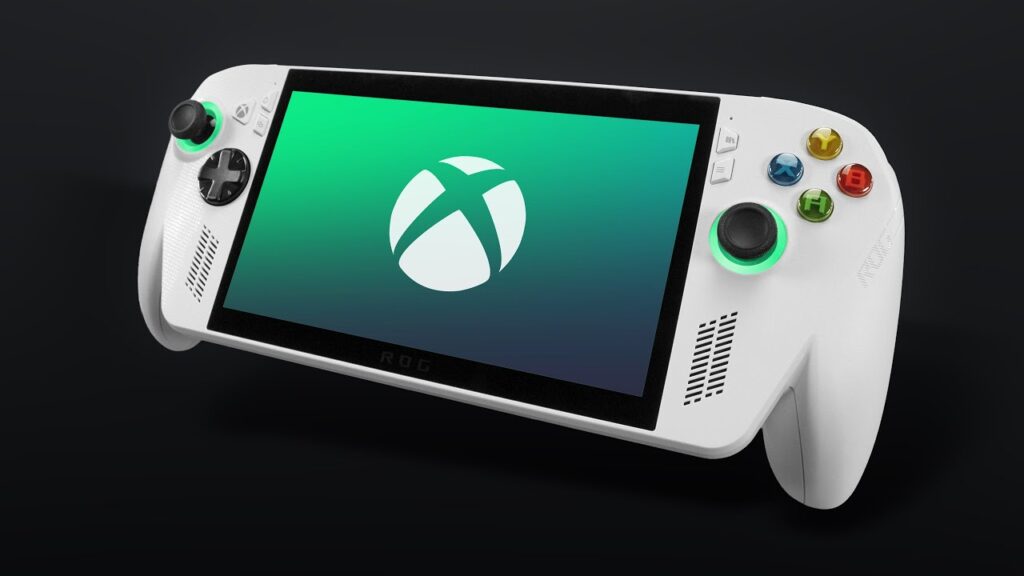
This focus on an “authentic Xbox experience” and imbuing the devices with the “soul of Xbox” points to an integration that goes far deeper than mere branding. It suggests a concerted effort to create a user experience that feels like a natural extension of the Xbox ecosystem, even though the devices operate on a Windows foundation. This is particularly noteworthy because previous Windows-based handhelds, while versatile, have often faced criticism for presenting a cumbersome Windows desktop environment on a compact screen, which can be unintuitive for controller-based navigation. Microsoft’s direct involvement aims to rectify this by introducing a “full screen Xbox experience” that launches by default. This specialized interface is designed to minimize the typical Windows overhead and prioritize controller-centric navigation, potentially offering a more user-friendly experience, especially for gamers accustomed to consoles.
Meet the Duo: ROG Xbox Ally and ROG Xbox Ally X
Microsoft and ASUS are not just launching one, but two distinct handheld models to cater to different segments of the gaming market.
The Standard ROG Xbox Ally: Your Entry to Portable Xbox
The standard ROG Xbox Ally is positioned as the more accessible gateway into this new family of Xbox handhelds. It features a clean, striking white finish, drawing a visual parallel to the Xbox Series S console. This model is powered by the AMD Ryzen™ Z2 A Processor, a chip specifically engineered to strike a careful balance between gaming performance and power efficiency. The goal is to maximize battery longevity without unduly compromising the quality of the gameplay experience. Accompanying the processor are 16GB of LPDDR5X-6400 RAM and a 512GB M.2 2280 Solid State Drive (SSD) for storage.
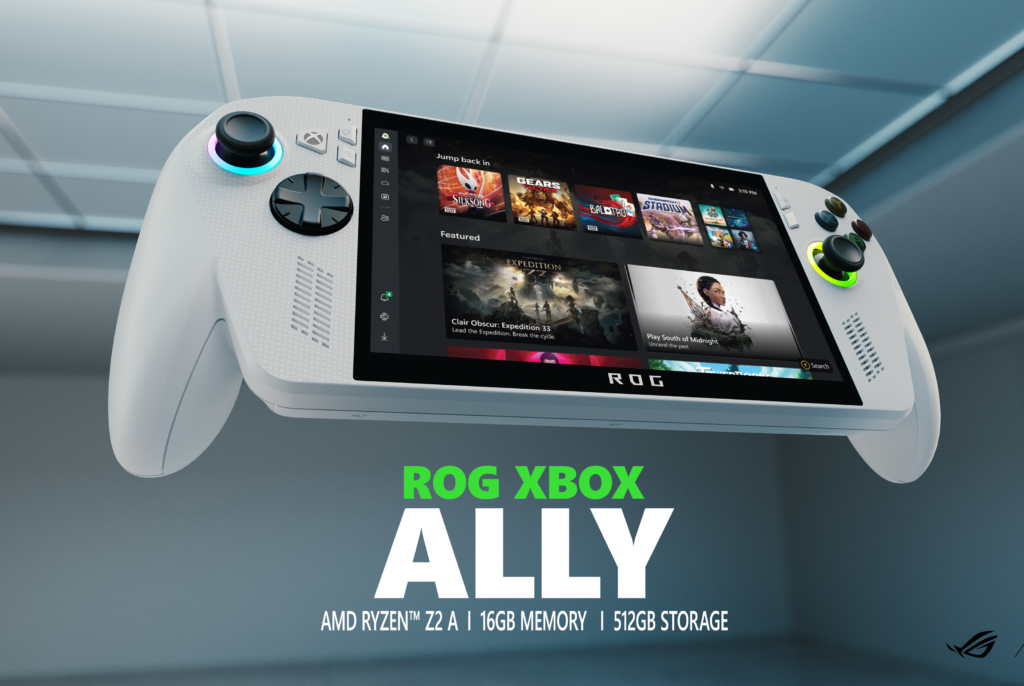
The AMD Ryzen Z2 A processor, while new, utilizes a 4-core/8-thread CPU based on AMD’s “Zen 2” architecture and features 8 RDNA 2 graphics cores. This architectural foundation places it, in terms of raw technology generation, closer to the APU found in Valve’s original Steam Deck. While this chip is designed for power efficiency and is expected to deliver a solid Xbox experience, particularly with Game Pass titles and less graphically demanding games, its performance ceiling for native AAA gaming will likely be noticeably lower than its more powerful sibling, the Ally X. Its market success will therefore heavily depend on its pricing relative to its performance and competing devices. Reports suggest it targets 720p gaming, which aligns with these hardware characteristics.
The ROG Xbox Ally X: The Ultimate Handheld Xbox Experience
For gamers who demand the pinnacle of portable performance, the ROG Xbox Ally X stands as the flagship offering. It sports a sophisticated black design, echoing the aesthetic of the Xbox Series X, and is internally equipped with significantly more powerful components. The heart of the Ally X is the new AMD Ryzen™ AI Z2 Extreme processor. This advanced chip boasts an 8-core/16-thread CPU built on AMD’s latest “Zen 5” architecture, cutting-edge RDNA 3.5 graphics, and, critically, an integrated Neural Processing Unit (NPU) dedicated to artificial intelligence tasks. This powerful APU is complemented by a generous 24GB of faster LPDDR5X-8000 RAM and a capacious 1TB M.2 2280 SSD.
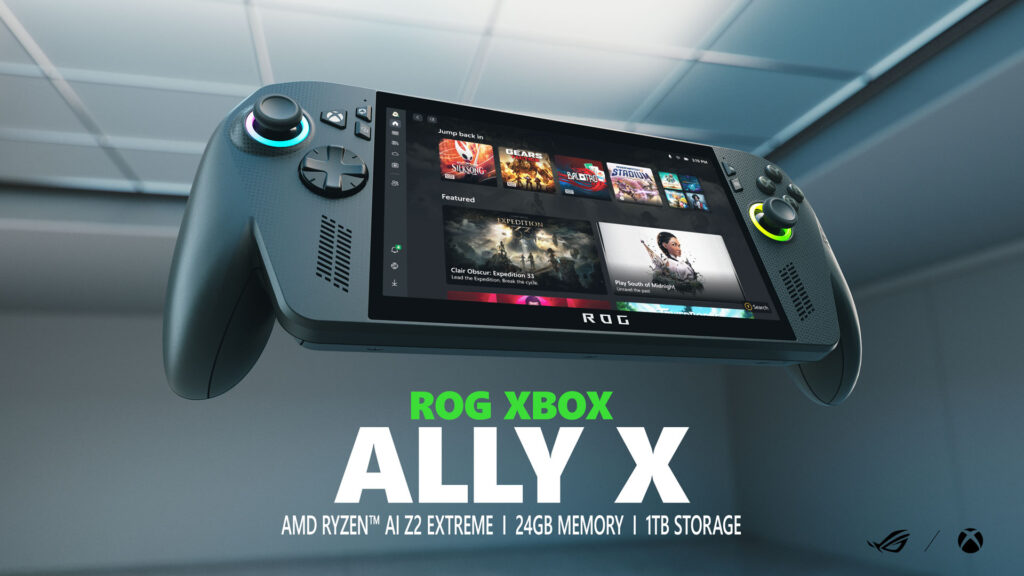
The “AI” designation in the Z2 Extreme processor is highly significant. The integrated NPU is engineered to “power the latest AI features as they are developed” and can deliver up to 50 TOPS (Trillion Operations Per Second) of AI compute power. This dedicated AI hardware opens the door to advanced features such as AI-driven image upscaling, potentially more sophisticated than current software solutions, and seamless integration with upcoming Xbox features like Copilot for Gaming. The inclusion of this NPU positions the Ally X not merely as a powerful handheld for current games but as a device with an eye toward the future of AI in gaming, potentially giving it a distinct advantage as these technologies mature.
Key Table: ROG Xbox Ally vs. ROG Xbox Ally X Specifications
To clearly delineate the capabilities of these two handhelds, the following table provides a side-by-side comparison of their core specifications:
| Feature | ROG Xbox Ally | ROG Xbox Ally X |
|---|---|---|
| Color | White | Black |
| Processor | AMD Ryzen™ Z2 A (Zen 2 CPU, RDNA 2 GPU) | AMD Ryzen™ AI Z2 Extreme (Zen 5 CPU, RDNA 3.5 GPU, NPU) |
| CPU Cores/Threads | 4-core/8-thread | 8-core/16-thread |
| GPU Cores | 8 RDNA 2 | 16 RDNA 3.5 |
| NPU | No | Yes (up to 50 TOPS) |
| RAM | 16GB LPDDR5X-6400 | 24GB LPDDR5X-8000 |
| Storage | 512GB M.2 2280 SSD | 1TB M.2 2280 SSD |
| Battery | 60Wh | 80Wh |
| USB-C Ports | 2x USB 3.2 Gen 2 Type-C | 1x USB4 Type-C (Thunderbolt 4 compatible), 1x USB 3.2 Gen 2 Type-C |
| Impulse Triggers | No (Hall Effect analog triggers) | Yes |
| Weight | 670g | 715g |
| Target Gaming | 720p / Balanced | 900p-1080p / High Performance |
This direct comparison underscores the distinct positioning of each model. The standard Ally offers a solid entry into Xbox handheld gaming, while the Ally X aims for a premium, high-performance experience with forward-looking AI capabilities.
Designed for Gamers: Comfort and Control
ASUS and Xbox have meticulously considered the physical interaction with these devices, ensuring that both comfort and control are paramount.
Ergonomics Inspired by the Xbox Controller
Drawing heavily from the widely acclaimed ergonomic design of the standard Xbox wireless controller, both ROG Xbox Ally models feature a completely re-engineered chassis. This includes larger, more contoured handgrips designed to fit naturally in the hands. The objective is to provide “all-day comfort” , achieved through redesigned palm rests and carefully applied texturing patterns. These elements work together to ensure a firm and secure hold, crucial for extended gaming sessions whether at home or on the move.
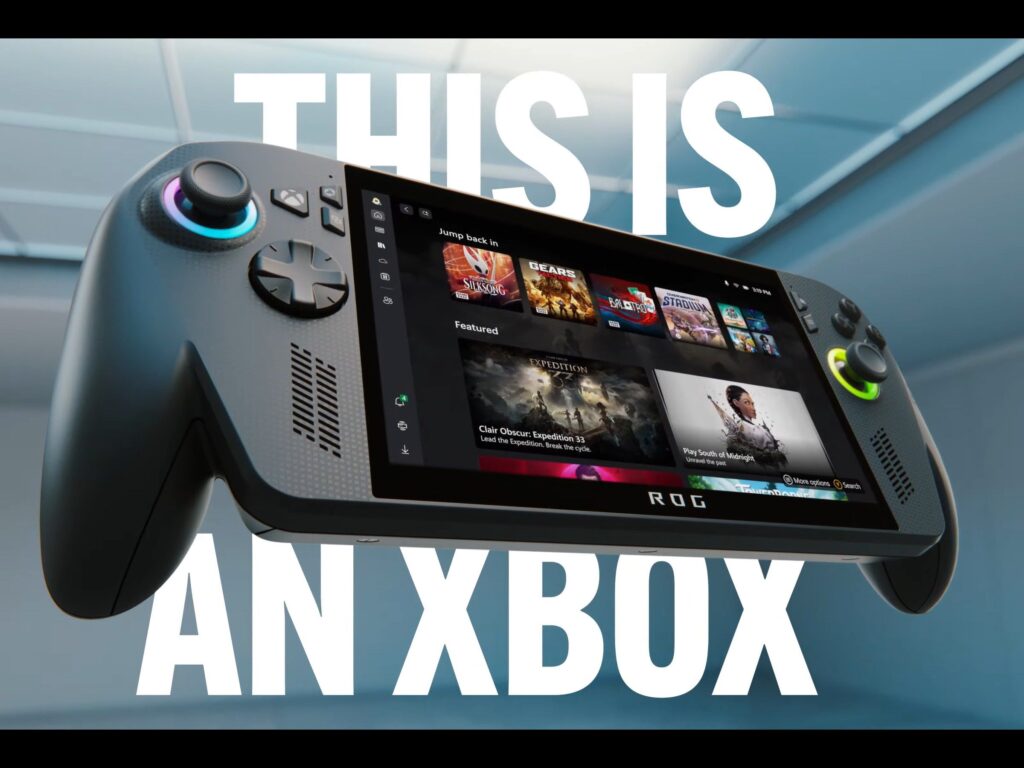
A Closer Look at the Physical Design
The two models are easily distinguishable by their color schemes: the standard ROG Xbox Ally is presented in white, while the more powerful ROG Xbox Ally X comes in black. ASUS asserts that these are the “most comfortable and immersive” handhelds the company has ever produced, even though they are marginally thicker and heavier than previous ROG Ally iterations and competitors like the Steam Deck. This evolution in design is the result of incorporating years of user feedback from the original Ally series, aiming to refine the tactile experience.
Buttons, Joysticks, and Triggers: Familiar Yet Enhanced
The control layout will feel immediately intuitive to anyone familiar with Xbox controllers. It features the classic ABXY button configuration, a D-pad, and the signature asymmetrical thumbstick placement. A dedicated Xbox button is conveniently located near the left joystick, offering quick access to the Xbox Game Bar, which itself has been revamped for improved usability on a handheld device.
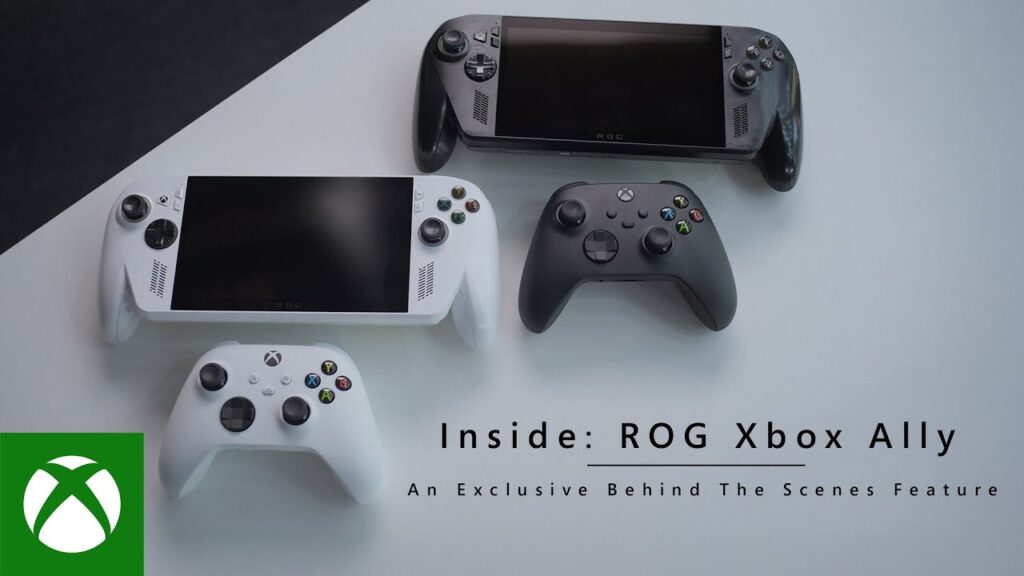
The ROG Xbox Ally X elevates the haptic experience with the inclusion of Impulse Triggers. This feature, a staple for Xbox console gamers, provides nuanced and responsive force feedback within the triggers themselves, enhancing immersion in compatible games. The standard ROG Xbox Ally, by contrast, is equipped with Hall Effect analog triggers, which still offer precision and durability. Both models also include left and right bumpers, View, Menu, Command Center, and Library buttons, along with two assignable grip buttons on the back and HD haptics for general vibrational feedback. Adding a touch of ROG flair, both devices feature customizable glowing lights surrounding the analog sticks, though users will likely have the option to adjust or disable these.
Weight and Portability: Built for the Road, With Considerations
In terms of physical heft, the standard ROG Xbox Ally tips the scales at 670 grams, while the ROG Xbox Ally X is slightly heavier, weighing 715 grams. While these devices are undoubtedly designed for portability, their weight is a factor to consider. For context, the Nintendo Switch 2 is reported to be considerably lighter at 534 grams , and the Steam Deck OLED weighs approximately 640 grams. This increased weight, particularly in the Ally X, is a direct consequence of accommodating larger batteries and more robust internal components necessary for their performance targets. The design choices reflect a prioritization of a substantial, console-like feel and high performance, potentially making them more appealing to core gamers who value these aspects over ultimate featherweight portability. The full controller-style grips, while enhancing comfort, also contribute to a “quite bulky” profile compared to slimmer alternatives.
The Visual Experience: Display Deep Dive
A crucial element of any gaming handheld is its screen, and ASUS has equipped both ROG Xbox Ally models with an identical, high-quality display.
The 7-inch Full HD IPS Panel
Both the ROG Xbox Ally and its more powerful X counterpart feature the same impressive 7-inch Full HD (1920×1080 pixels) In-Plane Switching (IPS) display, maintaining a standard 16:9 aspect ratio. This resolution, on a screen of this dimension, ensures that visuals are sharp and detailed, allowing games from AAA epics to intricate indie titles to appear crisp and clear.
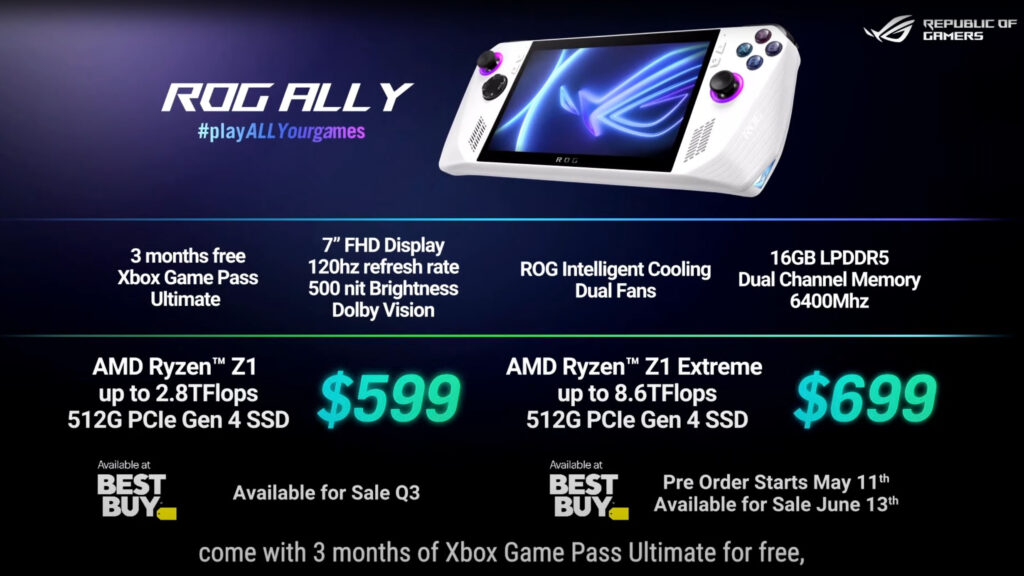
Smooth Gameplay: 120Hz Refresh Rate and FreeSync Premium
A standout feature of this display is its high 120Hz refresh rate. This allows for exceptionally smooth on-screen motion, a significant boon for games that can achieve frame rates approaching this level, leading to a more fluid and responsive visual experience. To further enhance this fluidity, the display supports AMD FreeSync™ Premium technology. This synchronizes the screen’s refresh rate with the frame output of the device’s GPU, effectively eliminating screen tearing and minimizing stutter, which contributes to a more seamless and reactive gaming feel.
[Image: A visual representation of the 120Hz refresh rate, perhaps a split screen showing the difference between 60Hz and 120Hz motion, or a game with motion blur trails looking crisp.]
Clarity and Durability: Brightness and Gorilla Glass Protection
The screen is rated for a peak brightness of 500 nits, which provides good visibility even in brightly lit indoor environments or shaded outdoor settings. To safeguard against the rigors of portable use, the display is protected by Corning® Gorilla® Glass Victus®, known for its enhanced drop and scratch resistance. Adding to its practicality, the screen also features a Corning DXC Anti-Reflection coating. This treatment helps to reduce surface reflections and glare, significantly improving visibility when gaming outdoors or under bright lights. The panel also covers 100% of the sRGB color space and has a 7ms response time, ensuring accurate color reproduction and sharp visuals during fast-moving game sequences.
While these display specifications are robust for an LCD panel, the choice to utilize LCD technology rather than an OLED (Organic Light Emitting Diode) screen—as seen in competitors like the Steam Deck OLED or many premium smartphones—may be a point of discussion for some potential buyers. OLED displays typically offer superior contrast ratios, true black levels, and often more saturated colors compared to even high-quality LCDs. The visual pop provided by an OLED screen was a noted improvement for the Steam Deck. While the ROG Xbox Ally’s IPS LCD is undoubtedly a high-performance panel with its 120Hz refresh rate and FreeSync Premium support, some enthusiasts might have anticipated an OLED option, particularly for the premium-tiered Ally X, especially if its price point is at the higher end of expectations. This decision could be influenced by factors such as cost, panel availability, or long-term durability considerations like burn-in (though this is less of an issue with modern OLEDs).
Powering Your Play: Hardware Specifications
The performance capabilities of the ROG Xbox Ally series are rooted in AMD’s new Ryzen Z2 family of Accelerated Processing Units (APUs), which have been specifically tailored for the demands of handheld gaming.
The Heart of the Machine: AMD Ryzen Z2 Processors
ROG Xbox Ally: The AMD Ryzen™ Z2 A Processor
The standard ROG Xbox Ally is powered by the AMD Ryzen™ Z2 A processor. This chip is engineered to provide a competent balance between gaming throughput and energy conservation, with the aim of extending battery life as much as possible. It incorporates a 4-core, 8-thread Central Processing Unit (CPU) based on AMD’s “Zen 2” microarchitecture, paired with 8 RDNA 2 architecture-based graphics cores. The processor’s configurable Thermal Design Power (TDP) can range from 6 to 20 watts, positioning it for reliable 720p gaming performance and efficiency in less demanding titles.
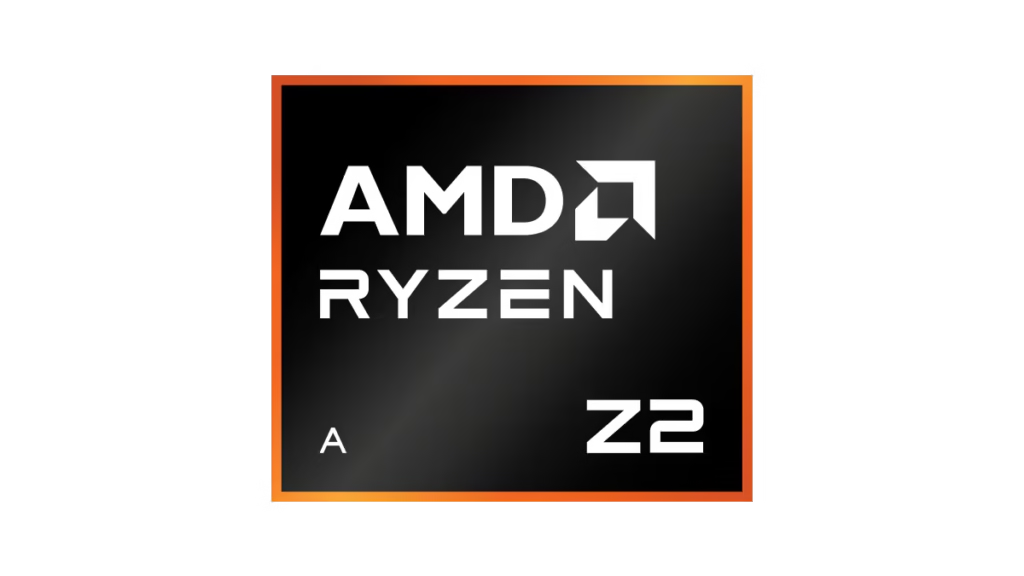
ROG Xbox Ally X: The AMD Ryzen™ AI Z2 Extreme Processor (with NPU)
The ROG Xbox Ally X takes a significant leap in processing power with the AMD Ryzen™ AI Z2 Extreme processor. Described as a “top-of-stack” APU , it’s designed to deliver “next-level gaming performance”. This formidable chip features an 8-core, 16-thread CPU built upon AMD’s latest “Zen 5” microarchitecture, which is coupled with 16 graphics cores based on the advanced RDNA 3.5 architecture. This APU is effectively a rebranded version of AMD’s laptop-focused Ryzen AI 9 HX 370 chipset.
A key differentiator for the Ryzen AI Z2 Extreme is its integrated Neural Processing Unit (NPU), capable of delivering up to 50 TOPS (Trillion Operations Per Second) of AI compute power. This NPU, based on AMD’s XDNA 2 architecture , is specifically included to accelerate artificial intelligence workloads within games and applications. This could manifest in features like advanced AI-driven upscaling, more intelligent game physics or NPC behavior, and direct support for tools like the upcoming Xbox Copilot for Gaming. The Ryzen AI Z2 Extreme is designed for a higher power envelope, configurable up to 35 watts , enabling it to tackle AAA games at higher graphical settings and frame rates, with a target of 900p to 1080p resolution. Microsoft has even confirmed its capability to run titles like Gears of War: Reloaded at a “completely stable 1080p 60 FPS”.

Memory on Demand: RAM Configurations
The standard ROG Xbox Ally is equipped with 16GB of LPDDR5X RAM operating at 6400MHz. This provides a sufficient memory pool for the majority of gaming scenarios anticipated for this model. The ROG Xbox Ally X receives a substantial upgrade in this department, featuring 24GB of faster LPDDR5X RAM, clocked at a brisk 8000MHz. This larger and speedier RAM capacity will be particularly beneficial for more demanding modern games, smoother multitasking, and generally future-proofing the device for upcoming software.
Storing Your Universe: SSD Storage and Expansion
Both models utilize M.2 2280 NVMe SSDs to ensure fast game loading times and overall system responsiveness. The standard ROG Xbox Ally comes with a 512GB SSD. The ROG Xbox Ally X doubles this internal storage, offering a 1TB M.2 2280 SSD, which provides ample space for a more extensive library of natively installed games. Importantly, the SSDs in both models are user-upgradeable, allowing for future expansion if needed.
Graphics Prowess: RDNA Architectures and AMD Software Suite
The graphical horsepower of these handhelds is delivered by integrated AMD Radeon graphics. The Z2 A processor in the standard Ally employs RDNA 2 graphics architecture , the same generation found in the Xbox Series S/X consoles and previous-generation AMD desktop and laptop GPUs. The Ryzen AI Z2 Extreme in the Ally X, however, leverages the more advanced RDNA 3.5 graphics architecture , which promises improved performance and power efficiency over its predecessor. Both APUs will benefit from AMD’s comprehensive software suite, including support for AMD FidelityFX™ Super Resolution (FSR) for intelligent upscaling, Radeon Super Resolution (RSR) for driver-level upscaling, and AMD Fluid Motion Frames (AFMF) for frame generation, all aimed at boosting frame rates and visual smoothness in compatible games.
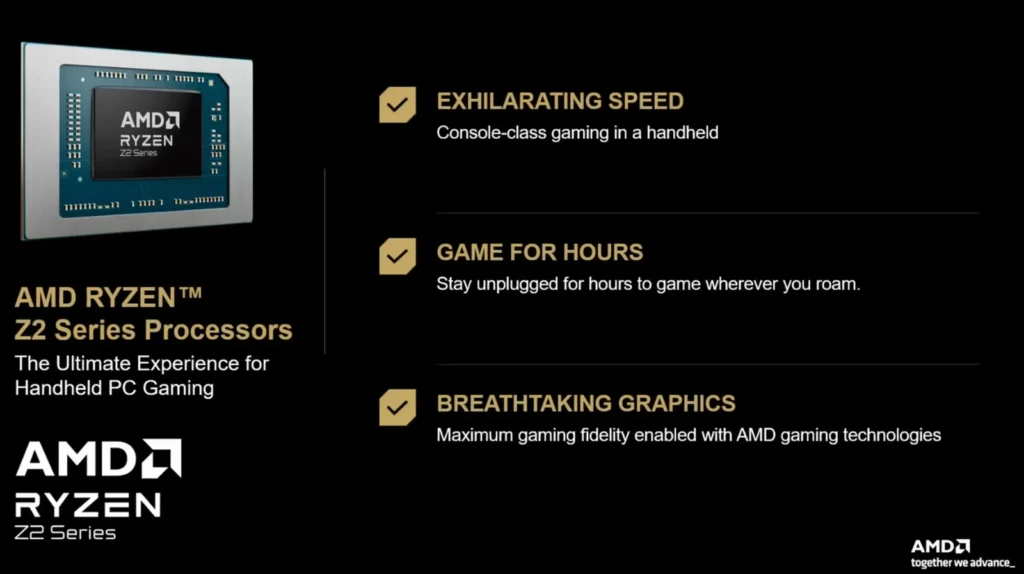
The performance difference between the Z2 A and the Ryzen AI Z2 Extreme is expected to be substantial, creating a clear two-tiered system that mirrors the strategy of the Xbox Series S and Series X consoles. The “AI” component in the Z2 Extreme, embodied by the dedicated NPU, is more than a marketing buzzword; it’s a functional hardware addition. This NPU could redefine how performance enhancements are achieved in handheld gaming if software developers widely adopt its capabilities. While FSR and AFMF are potent software solutions available today, dedicated on-device AI acceleration via the NPU could enable more sophisticated and efficient upscaling, frame generation, or other AI-driven game enhancements. These could be less reliant on game-specific implementations and potentially offer superior quality or lower performance overhead compared to purely software-based approaches on devices lacking NPUs. This is a crucial differentiator for the long-term potential and advanced capabilities of the ROG Xbox Ally X.
[Image: A conceptual image showing a brain/neural network graphic integrated into a processor, symbolizing the NPU’s AI capabilities enhancing game visuals or performance.]
A Seamless Interface: Software and User Experience
A major focus for Microsoft and ASUS has been to refine the software experience on these Windows-based handhelds, aiming for a more console-like feel.
Windows 11 Reimagined: The Full-Screen Xbox Experience
Both ROG Xbox Ally devices operate on Windows 11 Home, granting them access to the vast ecosystem of PC games, applications, and utilities. However, to directly address common criticisms regarding the usability of standard Windows on small, controller-operated handheld screens, Microsoft and ASUS have co-developed what they term a “full screen Xbox experience”. Upon powering on the device, users are immediately launched into this console-inspired user interface, which has been optimized for intuitive navigation using the built-in joysticks and buttons.
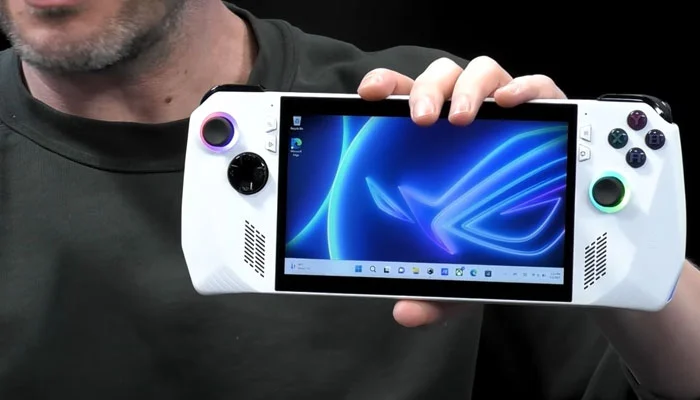
This specialized software layer is designed to achieve several goals: reduce system overhead by minimizing background Windows processes, defer non-essential tasks, and consequently allocate more system resources directly to games. This should translate to better in-game performance and a smoother overall user experience. This new Xbox application and the retooled Windows 11 environment are reportedly exclusive to the ROG Xbox Ally and Ally X models until “early 2026,” after which other devices may receive it.
[Image: A before-and-after style graphic: one side showing a cluttered Windows desktop on a small screen, the other showing the clean, optimized Xbox UI on the Ally.]
Navigating Your Games: Optimized UI and Game Bar
The new Xbox UI is engineered to be clean, responsive, and controller-first, mirroring the aesthetic and navigational principles of the established Xbox ecosystem found on consoles and other devices. A dedicated Xbox button provides instant access to an updated Game Bar overlay. This overlay offers quick shortcuts to settings, applications, chat functions, customizable widgets, and enables users to swiftly switch between recently played games.
ASUS Armoury Crate SE: Fine-Tuning Your Device
ASUS’s proprietary Armoury Crate Special Edition (SE) software is also deeply integrated into the system, providing a centralized hub for device management and performance optimization. Through Armoury Crate SE, users can access a range of customization options. These include selecting different performance modes (such as Silent, Performance, and Turbo), adjusting fan curves to balance cooling and noise, customizing joystick sensitivity and dead zones, remapping buttons, and managing other hardware-specific settings.
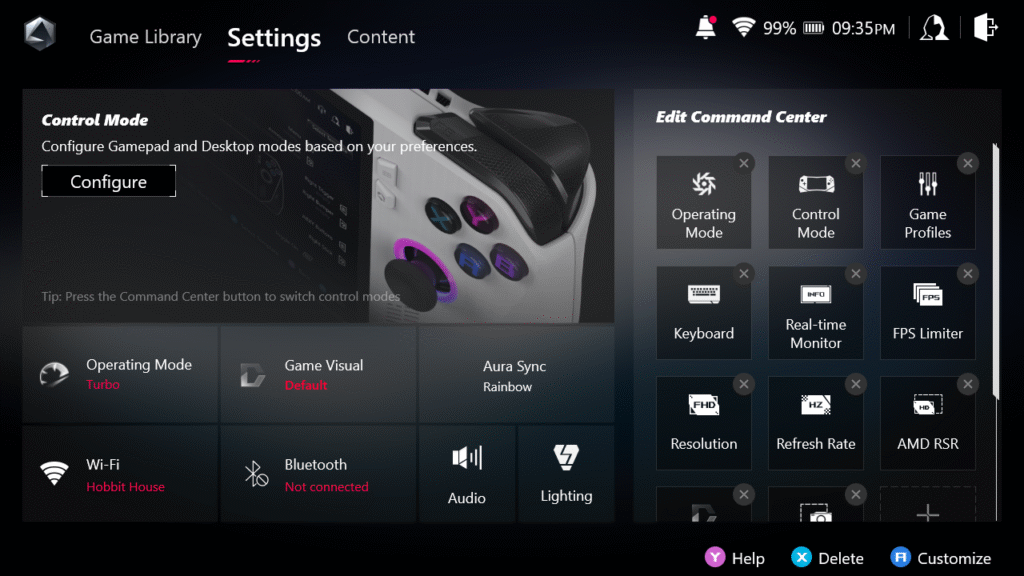
Beyond Xbox: Accessing Steam, Epic Games, and More
A significant advantage conferred by the Windows 11 operating system is the inherent freedom to install and play games from a multitude of PC storefronts. The ROG Xbox Ally series is not confined to the Microsoft Store or Xbox Game Pass. Users can install launchers and games from Steam, the Epic Games Store, GOG, and virtually any other PC game distributor. Furthermore, the new Xbox application features the ability to import and aggregate game libraries from these other storefronts, effectively functioning as an all-in-one launcher that presents a unified view of the user’s entire PC game collection.
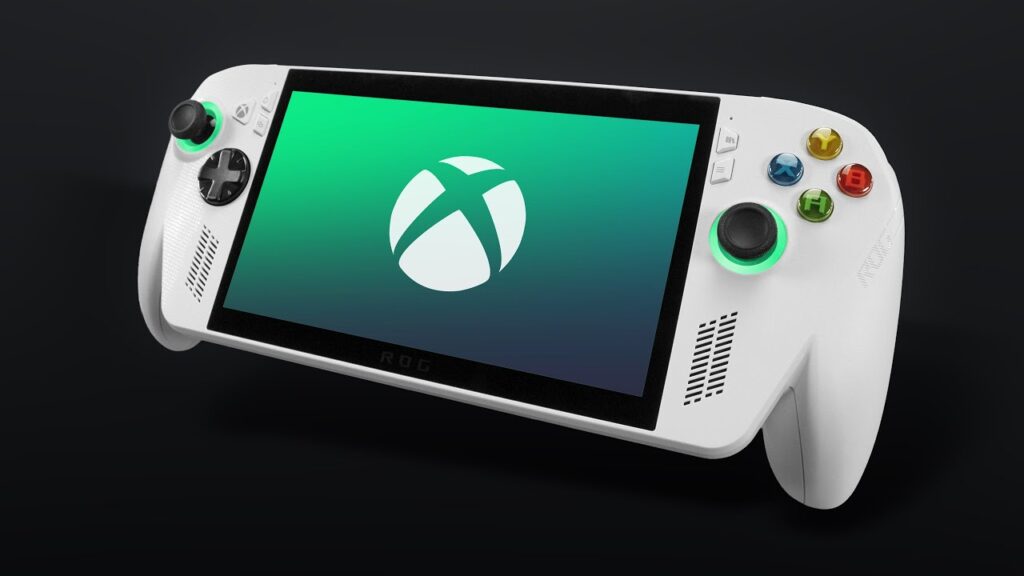
Xbox Play Anywhere: Pick Up Where You Left Off
The devices offer full support for the Xbox Play Anywhere initiative. For titles included in this program, players can begin a game on their Xbox console or Windows PC and then seamlessly resume their progress right where they left off on their ROG Xbox Ally. All game saves, achievements, and progress are automatically synchronized across compatible devices.
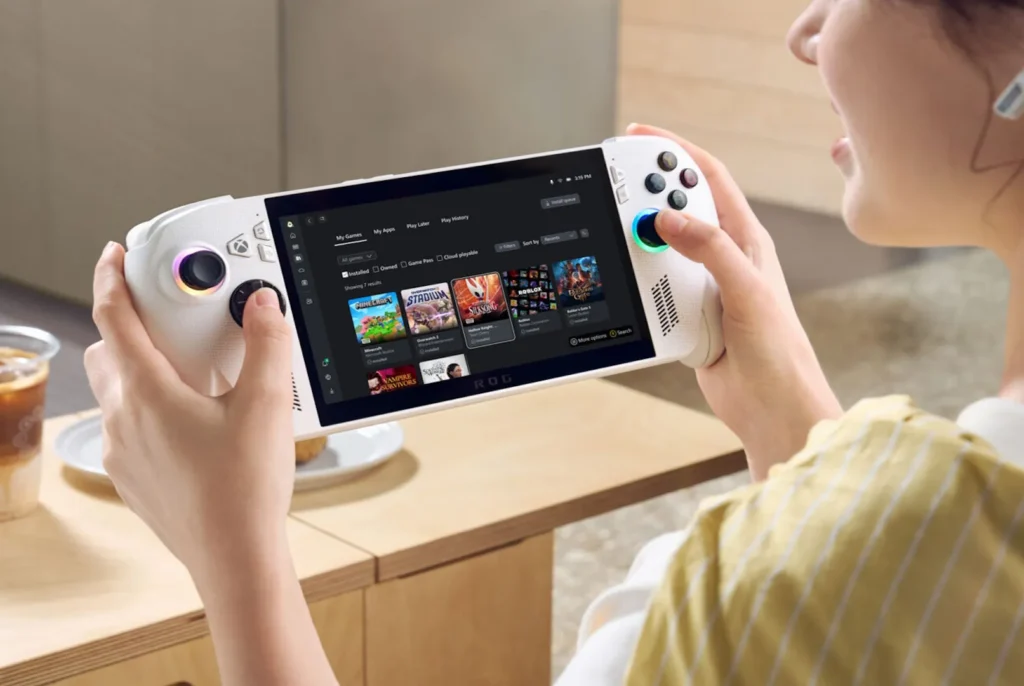
The Future with AI: Copilot for Gaming
Both the standard Ally and the Ally X are slated to ship with the recently announced Copilot for Gaming feature integrated into the Game Bar. This AI-powered assistant is described as a “personalized gaming companion” that can offer in-game help, guides, and potentially other contextual assistance as the technology evolves. The AMD Ryzen AI Z2 Extreme processor in the Ally X, with its dedicated NPU, is specifically engineered to efficiently power such AI-driven features, hinting at the potential for deeper and more sophisticated AI integration in the future.

The ultimate success of the ROG Xbox Ally series will heavily depend on how effectively Microsoft and ASUS execute this “full screen Xbox experience” overlay on Windows 11. It represents an ambitious attempt to combine the vast compatibility and openness of the PC gaming world with the streamlined, controller-friendly interface typically associated with gaming consoles. If this new Xbox UI genuinely mitigates the “clunkiness” often attributed to Windows on small screens and delivers a seamless, performant, and intuitive experience, it could be a transformative development for Windows-based handhelds, setting a new benchmark. The ability to aggregate game libraries from multiple storefronts is a particularly strong user-centric feature. However, if the Xbox layer feels like a superficial veneer over a still-awkward Windows core, or if it introduces its own set of bugs and performance issues, it could diminish the devices’ appeal when compared to more tightly integrated operating systems like SteamOS. Early hands-on impressions have suggested that the Xbox app design, while promising, still has “room for improvement” regarding its intuitiveness. The period of exclusivity for this new software until early 2026 provides Microsoft with a crucial window to refine and perfect this experience on these flagship partnered devices.
[Image: A split image: one side showing a frustrated gamer with a complex Windows UI on a handheld, the other a satisfied gamer with the streamlined Xbox UI on the Ally.]
Uncompromised Gaming: Performance and Features
The ROG Xbox Ally series is built from the ground up to deliver a compelling gaming experience across a wide spectrum of titles and services.
Native Gaming Prowess: AAA Titles on the Go
Engineered to handle a diverse range of PC games natively, the ROG Xbox Ally devices are capable of playing everything from charming indie releases to graphically demanding AAA blockbusters. The ROG Xbox Ally X, with its potent AMD Ryzen AI Z2 Extreme processor, substantial 24GB of RAM, and RDNA 3.5 graphics, is specifically designed to provide a high-fidelity gaming experience at 1080p resolution. Microsoft has even showcased its ability to run demanding titles like Gears of War: Reloaded at a consistent 60 frames per second on high settings.
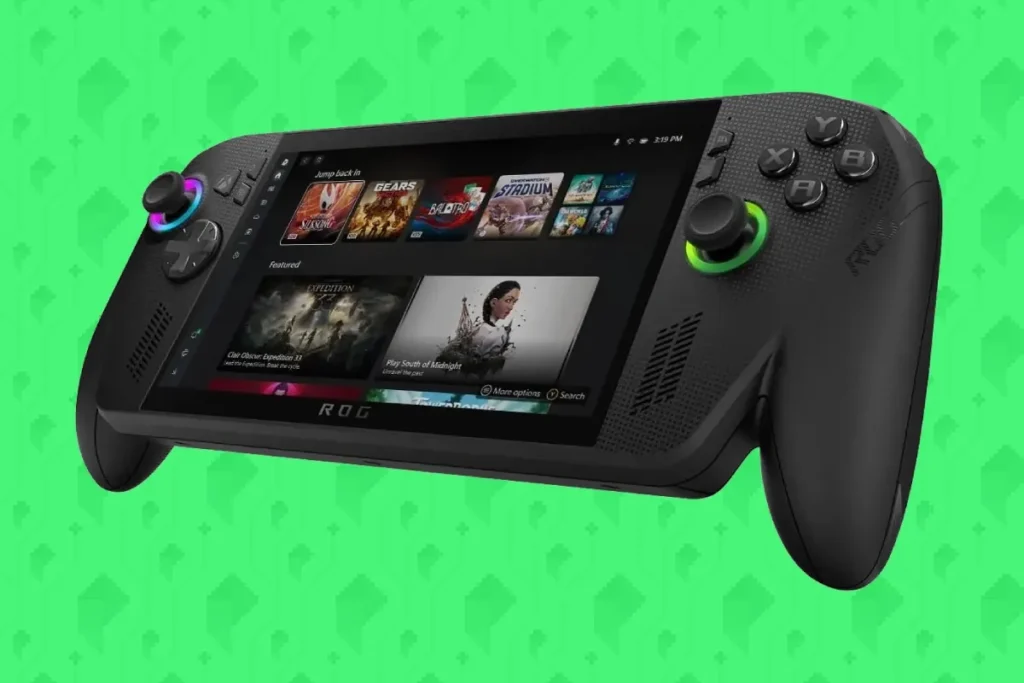
The standard ROG Xbox Ally, powered by the AMD Ryzen Z2 A processor, targets solid gameplay at 720p resolution. It aims to strike a balance between performance and battery conservation, making it suitable for a broad array of games, including many popular AAA titles at adjusted settings.
The Power of Game Pass: Hundreds of Games at Your Fingertips
Xbox Game Pass, a cornerstone of the Xbox ecosystem, is fully integrated and supported on the ROG Xbox Ally series. Subscribers will gain immediate access to a vast and continually updated library of hundreds of games directly on their handheld device, including numerous day-one releases from Xbox Game Studios and third-party partners. Microsoft has further sweetened the deal by announcing that 17 new titles, featuring highly anticipated games such as Tony Hawk’s Pro Skater 3+4, Ninja Gaiden 4, and The Outer Worlds 2, will be available on Game Pass PC & Ultimate from their launch day, all playable on these new handhelds.

Cloud Gaming and Remote Play Capabilities
In addition to native installations, the ROG Xbox Ally devices support Xbox Cloud Gaming (formerly known as xCloud). This allows users to stream games directly from Microsoft’s servers without needing to download or install them locally, which is ideal for conserving storage space or playing on the go with a stable internet connection. Remote Play functionality is also included, enabling users to stream games from their home Xbox console directly to their ROG Xbox Ally. This feature can be used whether they are in another room of the house or miles away, provided both devices have a suitable internet connection.
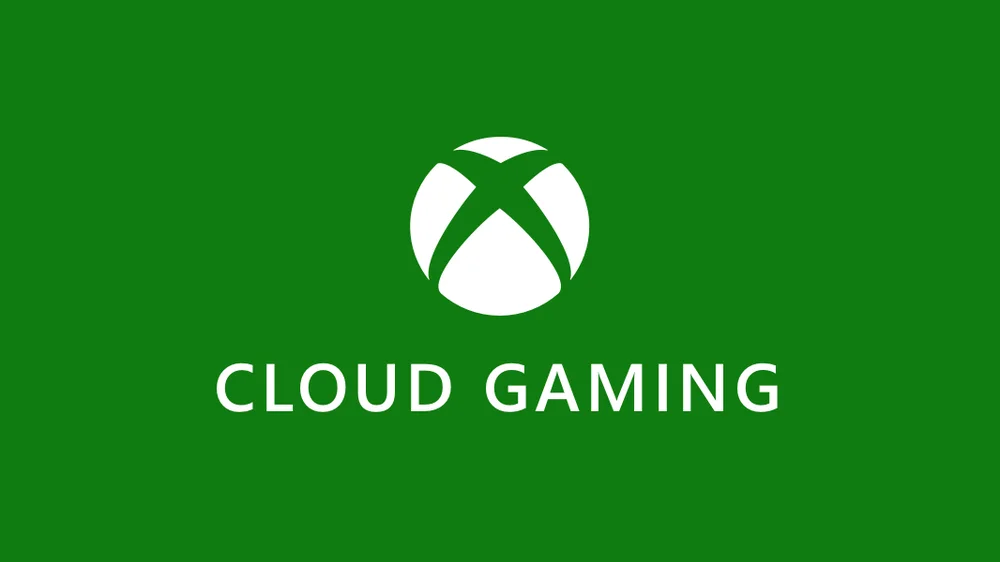
Expected Performance: What the Specs Translate To
The ROG Xbox Ally X is anticipated to deliver performance that meets or exceeds that of current high-end PC gaming handhelds. It should be capable of running modern AAA games at 1080p resolution with respectable frame rates, particularly when leveraging performance-enhancing technologies like AMD FSR. The standard ROG Xbox Ally, featuring the Z2 A processor, is expected to offer performance comparable to the original Steam Deck, making it a capable device for 720p gaming, a wide variety of indie titles, and older AAA games.
The actual gaming experience on these devices will, of course, depend significantly on how well individual games are optimized for these specific AMD Z2 APUs and how effectively the new Xbox software layer manages Windows 11 resources in the background. While the raw specifications are promising, real-world performance can vary based on a multitude of factors. PC gaming performance is a complex interplay of hardware capabilities, driver support, operating system overhead, and game-specific optimization. Although AMD’s APUs have made remarkable advancements, handheld devices still operate within tight thermal and power envelopes that can influence sustained performance, especially under heavy load. The effectiveness of AMD’s FSR and AFMF technologies will be particularly crucial for achieving smooth and playable frame rates at target resolutions in demanding titles, especially on the standard ROG Xbox Ally. The claim of a “completely stable 1080p 60 FPS” for Gears of War: Reloaded on the Ally X serves as a strong benchmark from Microsoft, but comprehensive performance across a broader library of unoptimized or more demanding third-party titles will ultimately be determined through independent reviews and testing.
Staying Connected: Ports and Wireless Tech
Comprehensive connectivity options are essential for a modern gaming handheld, and the ROG Xbox Ally series delivers on this front.
Wired for Action: USB-C, USB4, and DisplayPort
The standard ROG Xbox Ally is furnished with two USB 3.2 Gen 2 Type-C ports. Both of these ports support DisplayPort video output (variously cited as 1.4 or 2.1 compatibility) and Power Delivery 3.0, facilitating charging, high-speed data transfer, and connection to external monitors or televisions. The ROG Xbox Ally X enhances this configuration by upgrading one of its USB-C ports to the significantly more capable USB4 standard, which is also Thunderbolt 4 compatible. This USB4 port offers much higher bandwidth (up to 40Gbps), enabling support for faster external SSDs and more versatile docking solutions, including compatibility with the ROG XG Mobile external GPU (eGPU) for desktop-level graphics performance. The second port on the Ally X remains a USB 3.2 Gen 2 Type-C, also with DisplayPort 2.1 and Power Delivery 3.0 capabilities.
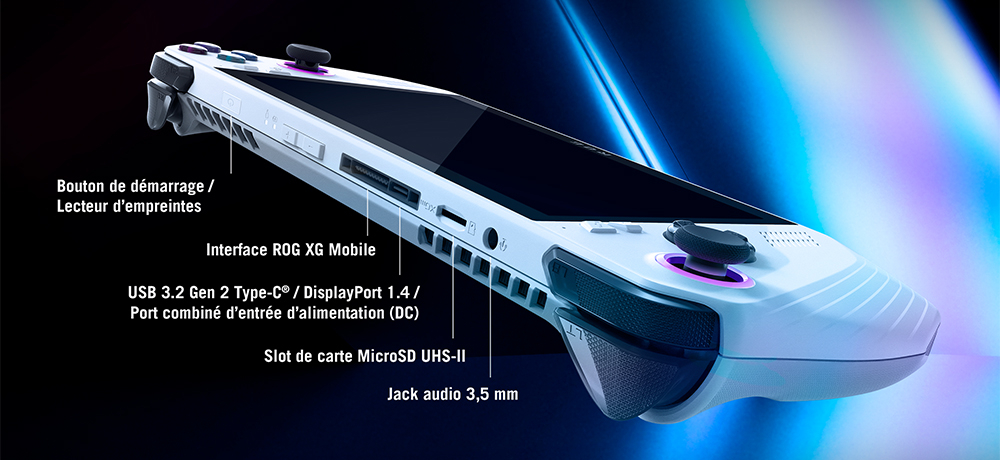
Expanding Your Library: UHS-II microSD Card Reader
To allow users to easily and cost-effectively expand their storage capacity for more games, media, and applications, both models incorporate a UHS-II microSD card reader. This high-speed card reader supports SD, SDXC, and SDHC cards. The reader on the Ally X also supports UHS-I with DDR200 mode for broader compatibility.
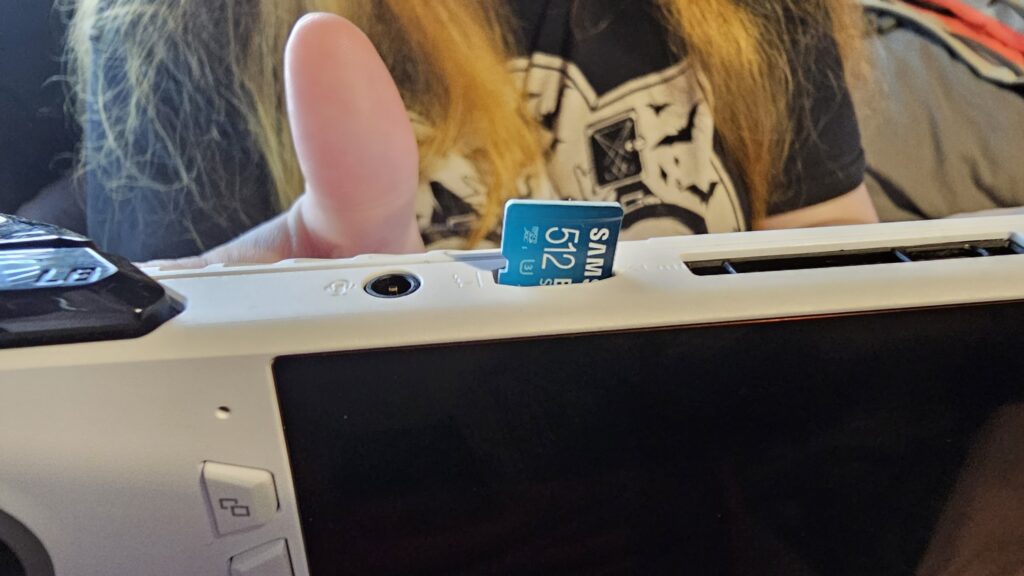
Wireless Freedom: Wi-Fi 6E and Bluetooth 5.4
For fast and stable wireless networking, both the ROG Xbox Ally and Ally X are equipped with Wi-Fi 6E (2×2) technology. This latest Wi-Fi standard operates on the 6GHz band (where available), offering lower latency, higher throughput, and reduced interference compared to older Wi-Fi standards. This is crucial for smooth online gaming experiences and quickly downloading large game files. Bluetooth 5.4 is also included, providing robust and energy-efficient wireless connections for peripherals such as controllers, headsets, and keyboards.
Audio Jack: For Your Favorite Headset
A standard 3.5mm combination audio jack is present on both models, allowing users to connect their preferred wired headphones or gaming headsets for private and immersive audio. In addition to the headphone jack, the devices feature built-in dual Smart Amp speakers with Dolby Atmos support for a richer, more spatial sound experience, and AI noise-canceling microphone technology for clearer voice chat.
The inclusion of a USB4/Thunderbolt 4 port on the ROG Xbox Ally X is a particularly significant differentiator. This high-bandwidth interface opens up a range of high-performance external peripheral use cases that go beyond what typical handheld consoles offer. Most notably, it enables robust support for external GPU solutions like ASUS’s own ROG XG Mobile. This allows the handheld to potentially transform into a much more powerful desktop-like gaming rig when docked and connected to an eGPU, capable of driving very high-resolution displays or achieving desktop-level frame rates. While the standard Ally can also connect to external displays via its USB-C ports, the Ally X’s USB4 port provides a more future-proof and significantly higher-performance expansion pathway. This reinforces the Ally X’s positioning as a premium, versatile device for users who desire maximum flexibility and the option for top-tier docked performance.
Endurance for the Journey: Battery Life
Battery life is a paramount concern for any portable gaming device, directly impacting its usability away from a power source.
Battery Capacities: 60Wh (Ally) vs. 80Wh (Ally X)
The standard ROG Xbox Ally is equipped with a 60Wh (watt-hour) battery. The ROG Xbox Ally X, designed for higher performance and consequently greater power draw, features a substantially larger 80Wh battery. ASUS suggests this larger capacity “should last longer than most handheld devices on the market” , aiming to provide extended playtime even with its more powerful internal components.
Maximizing Playtime: Efficiency and Power Modes
Both devices are intended to leverage the inherent power efficiency of their respective AMD Ryzen Z2 series processors, alongside the optimizations within the Windows 11 / Xbox software experience, to maximize battery duration. Users will have granular control over power consumption through various operating modes accessible via the Armoury Crate SE software. These modes, typically including options like Silent, Performance, and Turbo, allow users to strike a balance between raw performance output and battery conservation based on their current needs and gaming scenario.
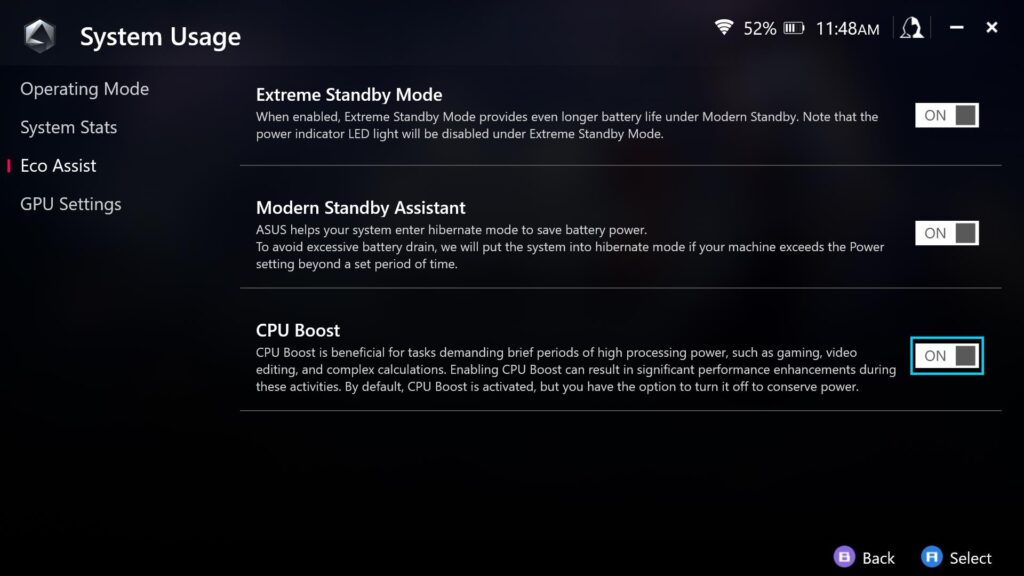
Real-world battery life will inevitably vary significantly depending on factors such as the graphical intensity of the game being played, screen brightness levels, Wi-Fi usage, and the selected power mode. For instance, historical data from the original ROG Ally indicated that running demanding AAA games in its highest performance (Turbo) mode could deplete the battery in approximately one hour, whereas less demanding 2D titles or lighter workloads could extend playtime to around three hours. The ROG Ally X, with its larger 80Wh battery, has shown promising results in tests conducted on existing (non-Xbox branded) Ally X models; these tests indicated around 3 hours of gaming battery life in demanding scenarios and over 8 hours in non-gaming use cases.
While the 80Wh battery in the ROG Xbox Ally X is a substantial capacity and a leader in the Windows handheld market , the significant power demands of its high-performance AMD Ryzen AI Z2 Extreme chip (which can be configured up to 35 watts ) mean that users should still maintain realistic expectations regarding multi-hour AAA gaming sessions at maximum settings when away from a power outlet. High-performance components inherently consume considerable power, and the Z2 Extreme is effectively a powerful laptop-grade APU housed within a handheld form factor. Even with an 80Wh battery, operating at peak performance (e.g., Turbo mode drawing 30-35W) would theoretically result in a maximum playtime of approximately 2.2 to 2.6 hours, and this doesn’t account for power consumed by other system components like the screen and wireless radios. Tests on a comparable ROG Ally X model (with a Z1 Extreme, likely having a similar power draw to the Z2 Extreme) demonstrated 2 hours and 15 minutes of playtime in Elden Ring at maximum settings, and 3 hours and 4 minutes in a PCMark 10 gaming loop. While this is excellent for a Windows handheld, it underscores the power-hungry nature of AAA gaming on such compact devices. The key to balancing performance and longevity will lie in the efficiency of the new Zen 5 cores and RDNA 3.5 graphics across various TDP levels, and how effectively the “optimized Xbox experience” manages background processes and power states. Users will likely need to actively manage power modes to tailor the device’s performance profile to their desired balance of power and endurance for extended play sessions.
Advanced Cooling for Peak Performance
Sustaining high performance in a compact handheld form factor requires a sophisticated cooling solution, an area where ASUS has considerable expertise.
ROG’s Cooling Technology Explained
To ensure that the ROG Xbox Ally series can maintain optimal performance during intense and prolonged gaming sessions, ASUS has integrated its advanced thermal management technologies. This approach builds upon ROG’s extensive experience in designing cooling systems for high-end gaming laptops and components. The cooling system likely incorporates features such as dual fans with fluid dynamic bearings for quiet and reliable operation, dust filters to prevent debris buildup, and innovative anti-gravity heat pipes. These heat pipes are designed to maintain their thermal transfer effectiveness even when the device is held upside down or in various orientations.
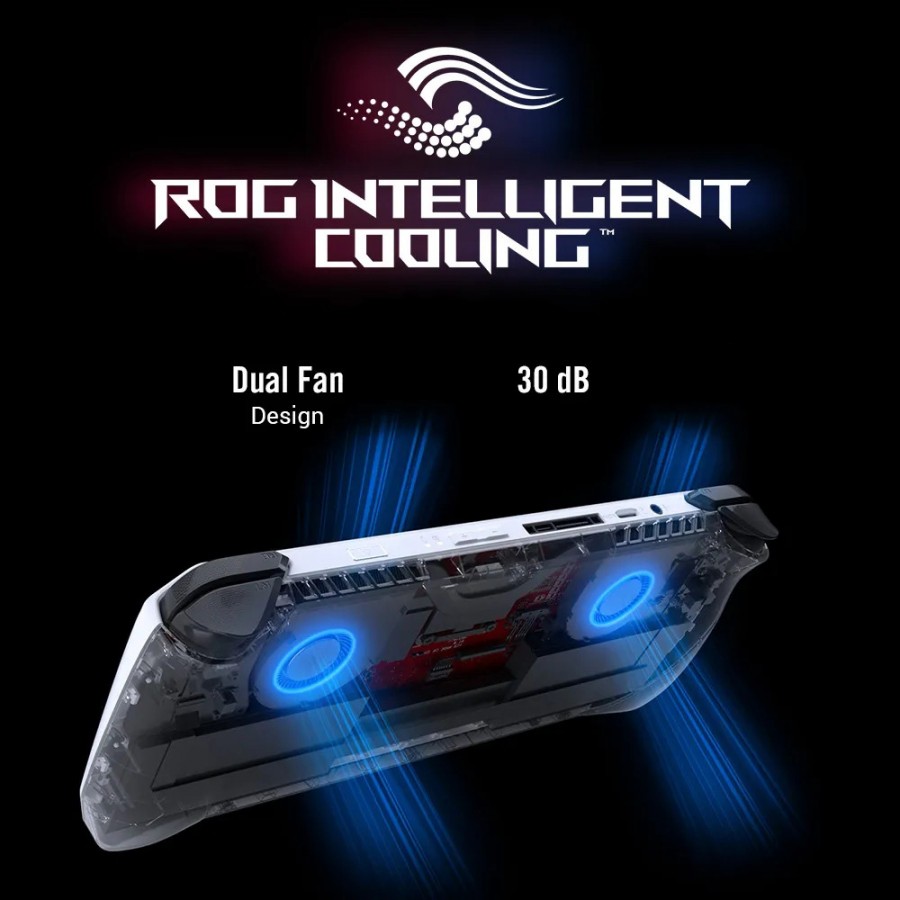
Specifically, the ROG Ally X (the 2024 model upon which the ROG Xbox Ally X is based) features redesigned fan shrouds that improve overall airflow by up to 24% and contribute to a cooler touch temperature on the display (up to 6°C cooler). A significant addition to this model is a new third exhaust vent, which further aids in heat dissipation. The fans themselves have been engineered to be thinner than previous designs, a change that not only creates more space for air to pass between each blade but also allowed for the inclusion of the larger 80Wh battery while still increasing overall airflow by 10%.
Maintaining Performance During Long Sessions
An effective cooling system is crucial not only for user comfort (preventing the device from becoming unpleasantly hot to hold) but also to prevent thermal throttling. Thermal throttling occurs when a processor automatically reduces its clock speed (and thus performance) to avoid overheating. A robust cooling solution helps to maintain consistent performance levels over extended periods of play. The thermal systems in the ROG Xbox Ally and Ally X are engineered to sustain peak performance while keeping fan noise at acceptable levels, ensuring an immersive gaming experience without undue auditory distractions.
The design of the cooling system, particularly for the more powerful AMD Ryzen AI Z2 Extreme processor in the ROG Xbox Ally X, will be a critical determinant in its ability to deliver on its promise of sustained high performance. The introduction of a third exhaust vent and the use of thinner, more efficient fans in the underlying ROG Ally X (2024) design indicate that ASUS is actively refining its thermal management strategies for these increasingly powerful handheld devices. Higher performance chips like the 35W Z2 Extreme inherently generate more heat. Effectively dissipating this heat within the confines of a compact handheld chassis, without creating an uncomfortably hot device or excessively loud fans, presents a significant engineering challenge. The previous generation of the ROG Ally did encounter some user concerns regarding heat concentration near the microSD card slot , suggesting that thermal management is an ongoing area of focus and iterative improvement for ASUS. The detailed cooling enhancements noted for the ROG Ally X (2024) platform —such as improved airflow, a cooler screen surface, and the additional exhaust vent—are likely directly incorporated into the ROG Xbox Ally X. These refinements are vital for enabling it to consistently deliver its “next-level gaming performance” without suffering from significant performance degradation due to heat during extended gameplay.
In the Box and Beyond: Accessories
The out-of-box experience and available accessories can significantly enhance the utility of a handheld gaming device.
What Comes with Your ROG Xbox Ally/Ally X
Upon purchasing either the ROG Xbox Ally or the ROG Xbox Ally X, users will find a 65W AC adapter for charging the device and a convenient stand included in the packaging. The stand can be useful for displaying the device or for comfortable tabletop gaming when using an external controller.

Optional Upgrades: The ROG XG Mobile eGPU
For users of the ROG Xbox Ally X seeking to elevate their gaming experience to desktop-like levels when at a home base, the device’s USB4 port enables compatibility with the 2025 iteration of the ROG XG Mobile external GPU (eGPU) dock. This powerful accessory can house high-performance laptop GPUs, with options available up to an NVIDIA GeForce RTX 5090 Laptop GPU. Connecting the Ally X to the XG Mobile can dramatically boost graphical processing power, enabling very high-resolution gaming, ultra-high frame rates on an external monitor, and demanding ray tracing effects. The XG Mobile also serves as an I/O expansion hub, providing additional ports for peripherals.

Beyond the XG Mobile, a range of other accessories designed for the broader ROG Ally family may also be compatible with the new Xbox versions. These can include items such as ROG wireless headsets for immersive audio, ROG Cetra True Wireless earbuds for on-the-go listening, protective travel cases, and alternative controllers like the ROG Raikiri Pro.
The compatibility of the ROG Xbox Ally X with the XG Mobile positions it as a true hybrid device, capable of bridging the gap between portable play and a high-end desktop gaming setup. However, this significant performance uplift comes at a considerable additional cost. External GPUs like the XG Mobile are premium accessories, often priced comparably to, or even exceeding, the cost of the handheld device itself. While this solution offers remarkable versatility and a massive leap in graphical power , it targets a specific niche within the handheld gaming market: users who prioritize having a single device that can serve both as a powerful portable and a high-performance docked PC, and who are willing to make a substantial financial investment to achieve this. This further underscores the ROG Xbox Ally X’s positioning as a premium, feature-rich system, but also highlights that unlocking its absolute maximum potential (as a desktop replacement) necessitates a significant extra outlay, pushing its total cost well into the territory of high-end gaming laptops or dedicated desktop gaming PCs.
**
The Handheld Landscape: How the ROG Xbox Ally Compares
The ROG Xbox Ally series enters a dynamic and increasingly competitive handheld gaming market. Understanding its position relative to established players is key.
ROG Xbox Ally Series vs. Valve’s Steam Deck
Valve’s Steam Deck has been a transformative force in the PC handheld gaming space, popularizing the concept for a mainstream audience. The ROG Xbox Ally series, particularly the standard model with its architecturally similar (though newer generation) APU base, directly competes in this segment. Key differentiators for the ROG Xbox Ally devices include their native Windows 11 operating system, which offers broader out-of-the-box game compatibility (including native support for Xbox Game Pass and other PC storefronts like the Epic Games Store), potentially higher raw performance (especially from the Ally X), and the deeply integrated Xbox software experience.

The Steam Deck, however, benefits from its highly optimized and user-friendly Linux-based SteamOS, a passionate and active community, and generally more aggressive pricing, particularly for its entry-level configurations. Furthermore, the Steam Deck OLED model offers a visually superior OLED display type compared to the LCD panels on the Ally series.
ROG Xbox Ally Series vs. Nintendo Switch 2
Microsoft’s handheld announcement closely followed the launch of the Nintendo Switch 2. While both product lines fall under the “handheld gaming” umbrella, they cater to fundamentally different core audiences and operate within distinct ecosystems. The ROG Xbox Ally series devices are powerful Windows PC handhelds, designed to play a vast library of PC games and leverage services like Xbox Game Pass. The Nintendo Switch 2, conversely, is a dedicated gaming console focused on Nintendo’s highly popular exclusive first-party franchises (like Mario, Zelda, and Pokémon) and a curated selection of third-party titles, offering a more closed and streamlined ecosystem.
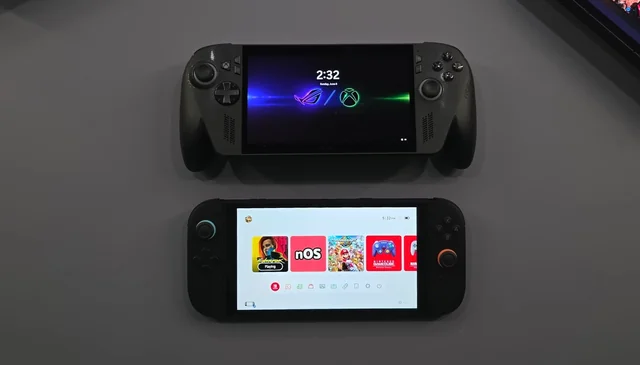
The Nintendo Switch 2 is expected to be significantly more affordable and lighter than the ROG Xbox Ally models. In contrast, the ROG Xbox Ally X will offer substantially more raw processing power and far greater versatility in terms of its game library due to its PC nature. The Switch 2 may also utilize technologies like NVIDIA’s DLSS for AI-powered upscaling to achieve cleaner visuals even if rendering at lower native resolutions.
Key Table: ROG Xbox Ally X vs. Key Competitors
The following table provides a high-level comparison to help illustrate the ROG Xbox Ally X’s positioning in the market:
| Feature | ROG Xbox Ally X | Steam Deck OLED (Example) | Nintendo Switch 2 (Expected) |
|---|---|---|---|
| OS | Windows 11 (Xbox Experience) | SteamOS (Linux) | Nintendo Proprietary OS |
| Processor | AMD Ryzen AI Z2 Extreme | Custom AMD APU (Zen 2/RDNA 2) | Custom NVIDIA Tegra |
| Display | 7″ 1080p 120Hz LCD | 7.4″ 800p 90Hz OLED | ~7.9″ 1080p LCD |
| RAM | 24GB LPDDR5X | 16GB LPDDR5 | TBD (Likely less than Ally X) |
| Key Strength | PC Game Library, Game Pass, Max Performance, AI | Optimized UI, Price/Performance, OLED Display | Nintendo Exclusives, Portability, Price |
| Primary Game Access | Xbox, Steam, Epic Games, GOG, etc. | Steam | Nintendo eShop, Cartridges |
This comparison highlights that the ROG Xbox Ally series, particularly the X model, is not attempting to directly replicate the appeal of the Nintendo Switch or the value proposition of the base Steam Deck. Instead, it is carving out a distinct niche for a premium, Windows-based Xbox handheld experience. This experience prioritizes unparalleled versatility in game access and raw performance, targeting users who are willing to invest more for these capabilities and are comfortable navigating the Windows ecosystem (even in its more streamlined Xbox form). Its core appeal is likely to be strongest among gamers already heavily invested in the PC and Xbox ecosystems who desire a no-compromise portable solution, or those who value a single device that can function as both a powerful handheld and, with accessories like the XG Mobile, a capable docked PC. This is a different value proposition than the plug-and-play simplicity and exclusive content of the Switch, or the more open-source, tinker-friendly nature of the Steam Deck for some users.
The Road Ahead: Price, Release, and Final Thoughts
The launch of the ROG Xbox Ally and Ally X marks an exciting new venture for Microsoft and ASUS, but several key factors will determine their ultimate success in the competitive handheld market.
Anticipated Launch: Holiday 2025
Microsoft and ASUS have officially announced that both the ROG Xbox Ally and the ROG Xbox Ally X are scheduled to launch towards the end of 2025, specifically targeting the holiday season. Initially, these devices will be available in 28 select markets, with plans for a broader rollout to additional regions to follow.

Price Point: What We Know (and Don’t Know)
As of their unveiling, official pricing for the ROG Xbox Ally and Ally X has not been disclosed by either Microsoft or ASUS. This remains the most significant unanswered question and a crucial factor for potential buyers. Speculation is widespread, with many industry watchers anticipating that the ROG Xbox Ally X, given its high-end specifications (including the Ryzen AI Z2 Extreme processor, 24GB of RAM, and 1TB SSD), will carry a premium price tag. Estimates often place it in the $799 to $999 range, or potentially even higher, especially considering that existing powerful Windows handhelds like the original ASUS ROG Ally X (non-Xbox branded) saw its price for a 1TB model increase to $899 in some markets. The standard ROG Xbox Ally is expected to be more affordable, but its exact price positioning relative to competitors like the Steam Deck is still unknown, though some analysts suggest a price around $500 for this Z2 A equipped model.

Is the ROG Xbox Ally Right for You?
The ROG Xbox Ally series represents a compelling new direction for both the Xbox brand and the broader handheld PC gaming landscape. The decision between the standard ROG Xbox Ally and the more powerful ROG Xbox Ally X will ultimately hinge on individual performance requirements, desired features (like the NPU and Impulse Triggers on the X model), and, crucially, budget.
For dedicated Xbox enthusiasts, avid Game Pass subscribers, or PC gamers seeking a potent and versatile handheld device that offers a familiar ecosystem and access to an enormous library of games, these new handhelds are undoubtedly worth keeping a very close watch on. As more details emerge, particularly regarding the all-important pricing structure, their value proposition will become clearer.
The Holiday 2025 launch window is strategically significant, aiming to capture peak consumer spending. However, it also presents challenges. By late 2025, the Nintendo Switch 2 will have been available for several months, potentially establishing a strong software library and loyal user base. Valve may also introduce newer iterations or price adjustments for its Steam Deck line. The real-world performance and user experience of the “optimized Xbox experience” on Windows will have been thoroughly tested by early adopters and reviewers, heavily influencing broader consumer perception. If the ROG Xbox Ally X is priced at the higher end of current speculation (e.g., $900 or more ), it will likely be a considerable investment, potentially limiting its audience to the most dedicated hardware enthusiasts. The pricing of the standard ROG Xbox Ally, relative to the Steam Deck and Nintendo Switch 2, will be pivotal for its mainstream adoption. A price point perceived as too high for its offered performance could relegate even the standard model to a niche product, especially if it doesn’t demonstrably outclass similarly priced or cheaper alternatives in key areas. The coming months will be crucial as more information, especially on pricing and specific release dates, comes to light, shaping the future of Xbox gaming on the go.
XBOX ROG ALLY